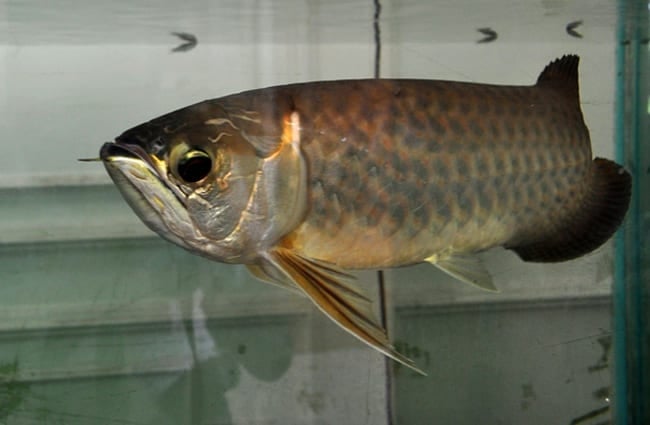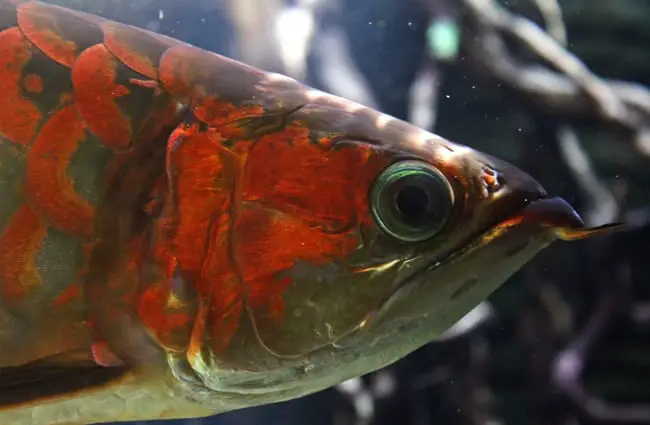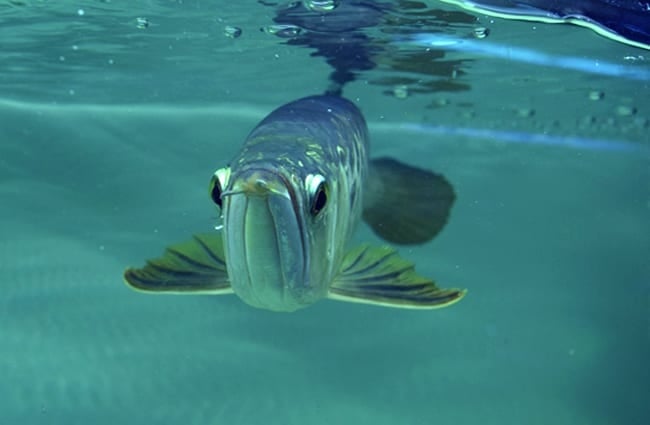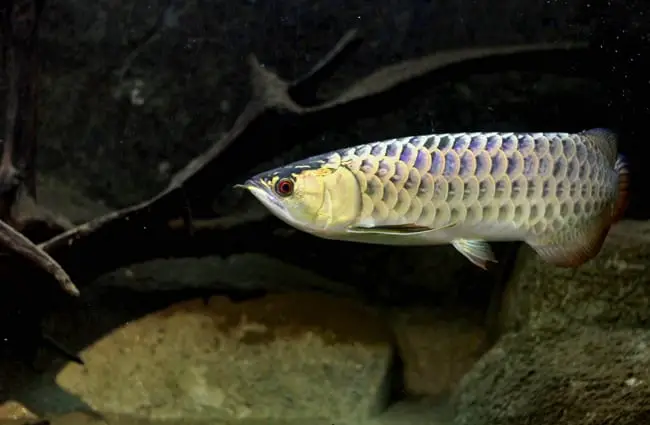Deep within the ancient waterways of the world, a creature of myth and majesty glides through the currents. Known to many as the “Dragon Fish,” the Arowana is not merely a fish, but a living relic, a testament to millions of years of evolution. Its shimmering scales, powerful body, and distinctive barbels evoke images of mythical dragons, captivating the imagination of scientists, aquarists, and cultural enthusiasts alike. This comprehensive guide delves into the fascinating world of the Arowana, uncovering its secrets from evolutionary origins to its intricate role in ecosystems and human culture.

A Glimpse into the Past: The Arowana’s Ancient Lineage
The Arowana belongs to the family Osteoglossidae, a name derived from Greek words meaning “bone tongue,” referring to the prominent bony plate on the floor of its mouth. This family boasts an incredibly ancient lineage, often referred to as “living fossils.” Fossil records indicate that Arowanas have existed in a remarkably similar form for over 100 million years, predating many modern fish species and even the dinosaurs’ demise. Their evolutionary journey spans the supercontinent Gondwana, explaining their current disjunct distribution across South America, Africa, Asia, and Australia. This deep history makes studying Arowanas akin to peering through a window into the Mesozoic Era, offering invaluable insights into vertebrate evolution.
Evolutionary Milestones
- Gondwanan Distribution: The presence of Arowana species on continents now separated by vast oceans is strong evidence of their ancient origins on the supercontinent Gondwana. As the landmasses drifted apart, different Arowana species evolved in isolation.
- Primitive Features: Their large, bony scales, dorsal and anal fins set far back on the body, and the unique mouth structure are all considered primitive traits, highlighting their ancient evolutionary path.
- Adaptive Success: Despite their ancient morphology, Arowanas have proven incredibly adaptable, thriving in diverse freshwater environments for eons.
Where the Wild Things Are: Arowana Habitats
Arowanas are primarily freshwater fish, inhabiting a range of tropical and subtropical environments across several continents. Their preferred habitats are typically slow-moving or still waters, rich in vegetation, which provide ample cover for hunting and refuge. Understanding their natural environment is crucial for anyone hoping to observe these magnificent creatures in the wild or provide optimal care in captivity.
Global Distribution and Specific Habitats
- South America: The Silver Arowana (Osteoglossum bicirrhosum) and Black Arowana (Osteoglossum ferreirai) are iconic residents of the Amazon and Essequibo River basins. They favor blackwater rivers, flooded forests, and oxbow lakes, often found near submerged roots and overhanging vegetation.
- Southeast Asia: The Asian Arowana (Scleropages formosus), also known as the Dragon Fish, inhabits peat swamps, slow-moving rivers, and flooded forests across countries like Malaysia, Indonesia, Thailand, and Vietnam. These environments are often characterized by acidic, tannin-stained waters.
- Australia and New Guinea: Species like the Saratoga (Scleropages jardinii) and Gulf Saratoga (Scleropages leichardti) are found in the rivers and billabongs of northern Australia and southern New Guinea. They prefer clear, slow-flowing waters with plenty of aquatic plants and submerged timber.
- Africa: The African Arowana (Heterotis niloticus) is found in a wide range of freshwater systems across West and Central Africa, including the Nile, Niger, and Senegal River basins. Unlike its predatory relatives, this species is primarily a filter feeder.
Finding Arowanas in the Wild
For the dedicated animal lover or aspiring zoologist hoping to spot an Arowana in its natural habitat, patience and local knowledge are key. Focus on areas with:
- Slow-moving or Stagnant Waters: Look for backwaters, oxbow lakes, flooded forests, and calm sections of rivers.
- Dense Vegetation: Arowanas often lurk near submerged logs, roots, and overhanging branches, using them for cover.
- Surface Activity: Being surface feeders, they are often seen near the water’s surface, especially during dawn or dusk when insects are abundant. Look for ripples or splashes indicating a strike.
- Local Guides: Engaging experienced local guides who know the specific habits and locations of these fish will significantly increase your chances of a sighting.

The Apex Predator: Diet and Hunting Strategies
Most Arowana species are formidable predators, perfectly adapted to their role as surface hunters. Their upturned mouths, powerful jaws, and keen eyesight are all specialized for ambushing prey from above. The African Arowana is a notable exception, primarily feeding on plankton and detritus.
Arowana’s Diverse Diet
- Insects: A primary food source, especially terrestrial insects that fall onto the water’s surface or are caught mid-air with impressive leaps.
- Small Fish: Other smaller fish species inhabiting the same waters are a significant part of their diet.
- Amphibians and Reptiles: Frogs, lizards, and even small snakes that venture too close to the water’s edge can become prey.
- Small Mammals and Birds: Larger Arowana species have been observed leaping out of the water to snatch small birds, bats, or rodents from overhanging branches. This incredible acrobatic feat has earned them the nickname “water monkeys” in some regions.
- Crustaceans: Shrimp and crabs are also consumed when available.
Hunting Techniques
Arowanas are ambush predators. They typically patrol the water’s surface or lurk beneath vegetation, waiting for an opportune moment. Their powerful caudal fin allows for sudden bursts of speed, and their ability to leap several feet out of the water is legendary. This combination of stealth, speed, and agility makes them highly effective hunters in their aquatic environments.
Arowana Love Story: Mating and Reproduction
The reproductive strategies of Arowanas are as fascinating as their ancient lineage, characterized by elaborate courtship rituals and dedicated parental care, particularly mouthbrooding. This method significantly increases the survival rate of their offspring.
The Mating Process
- Courtship: During the breeding season, which often coincides with the rainy season in their natural habitats, Arowanas engage in courtship displays. This can involve synchronized swimming, fin flaring, and territorial defense.
- Spawning: The female lays a relatively small number of very large eggs, typically ranging from 10 to 200 depending on the species and size of the fish. These eggs are often yellowish or reddish in color.
- Fertilization: The male then fertilizes the eggs.
The Art of Mouthbrooding
A defining characteristic of many Arowana species, particularly the Asian and South American varieties, is mouthbrooding. After fertilization, one of the parents, usually the male, collects the eggs into its mouth. This protective behavior continues throughout the incubation period and even after the fry hatch.
- Incubation: The eggs incubate inside the parent’s mouth for several weeks, typically 40 to 60 days. During this time, the parent will not feed, dedicating all its energy to protecting the developing eggs.
- Hatching and Fry Care: Once hatched, the fry remain in the parent’s mouth, feeding on their large yolk sacs. They will periodically emerge to explore their surroundings but quickly retreat back into the safety of the parent’s mouth at the first sign of danger. This parental care can last for several more weeks until the fry are large enough to fend for themselves.

Giants of the Ecosystem: Role and Interactions
As apex predators in their respective freshwater ecosystems, Arowanas play a crucial role in maintaining ecological balance. Their presence influences the populations of their prey species and contributes to the overall health and biodiversity of their habitats.
Contribution to the Ecosystem
- Population Control: By preying on smaller fish, insects, and other animals, Arowanas help regulate the populations of these species, preventing overpopulation and ensuring a healthy food web.
- Indicator Species: A healthy Arowana population can indicate a robust and relatively undisturbed freshwater ecosystem, as they require specific water quality and habitat conditions.
- Nutrient Cycling: As predators, they are part of the energy transfer within the food chain, contributing to nutrient cycling within their aquatic environments.
Interaction with Other Animals
Arowanas primarily interact with other animals through predation. However, they also share their habitats with a variety of other species:
- Prey Species: They interact with numerous species of smaller fish, aquatic insects, frogs, and even small terrestrial animals that become part of their diet.
- Competitors: In some habitats, they may compete with other large predatory fish for food resources.
- Symbiotic Relationships: While not direct symbiosis, their presence can influence the behavior and distribution of other species in the ecosystem. For instance, smaller fish might seek refuge in denser vegetation to avoid Arowana predation.
- Predators of Arowanas: While adults are largely invulnerable due to their size, young Arowanas can fall prey to larger fish, birds of prey, or even crocodiles and caimans in their native ranges.
Arowanas and Us: Cultural Significance and Human Interaction
Beyond their ecological importance, Arowanas hold a unique place in human culture, particularly the Asian Arowana, which has become a symbol of status, wealth, and good fortune. This cultural reverence, however, also brings challenges related to conservation and human interaction.
Cultural Contribution
- Symbol of Prosperity: In many Asian cultures, the Asian Arowana is revered as a symbol of luck, wealth, and prosperity. Its dragon-like appearance is believed to ward off evil spirits and bring good fortune to its owner.
- Status Symbol: Owning a high-quality Asian Arowana, especially rare color morphs, is a significant status symbol, leading to exorbitant prices in the aquarium trade.
- Feng Shui: Arowanas are often kept in aquariums according to Feng Shui principles, believed to enhance positive energy and bring harmony to a home or business.
Interaction with Humans
Human interaction with Arowanas is multifaceted, ranging from admiration to exploitation:
- Pet Trade: The Arowana, particularly the Asian Arowana, is one of the most sought-after and expensive aquarium fish globally. This demand fuels both legal, regulated breeding operations and illegal poaching.
- Conservation Challenges: Due to habitat destruction, pollution, and overcollection for the pet trade, many Arowana species, especially the Asian Arowana, are listed under CITES (Convention on International Trade in Endangered Species of Wild Fauna and Flora) Appendix I. This means international commercial trade is prohibited, and permits are required for non-commercial purposes.
- Aquaculture: To meet demand and aid conservation, significant efforts are made in aquaculture to breed Arowanas in captivity. These farmed fish are often microchipped for identification and legal trade.
- Fishing: In some regions, Arowanas are caught for food, though this is less common for the highly prized Asian species.

Encountering the Dragon: Tips for Wild Encounters
Encountering an Arowana in its natural habitat is a rare and thrilling experience. For hikers, researchers, or nature enthusiasts, knowing how to react responsibly is paramount.
What to Do if You Encounter an Arowana in the Wild
- Observe from a Distance: Maintain a respectful distance to avoid disturbing the fish. Arowanas are sensitive to sudden movements and noise.
- Do Not Disturb: Refrain from attempting to catch, touch, or feed the Arowana. Interfering with wild animals can stress them, alter their natural behavior, and potentially be illegal, especially for protected species.
- Respect Their Habitat: Ensure your presence does not pollute or damage their environment. Pack out all trash and avoid introducing foreign substances into the water.
- Appreciate the Moment: Take a moment to appreciate this ancient and magnificent creature in its natural setting. It is a privilege to witness such a living fossil.
- Report Sightings (if applicable): If you are in a protected area or involved in a research project, reporting your sighting to local authorities or researchers can contribute valuable data to conservation efforts.
Caring for a Living Fossil: Zookeeper Insights
Caring for Arowanas in captivity, whether in a public aquarium or a private collection, requires specialized knowledge and dedication. Zookeepers and experienced aquarists must replicate their natural environment as closely as possible to ensure their health and well-being.
Essential Zookeeper Tasks for Arowana Care
- Tank Size and Setup: Arowanas grow very large, requiring immense tanks. For adult Asian or Silver Arowanas, tanks of 250 gallons (950 liters) or more are often necessary, with lengths exceeding 8 feet (2.4 meters). The tank should have a secure lid, as Arowanas are notorious jumpers.
- Water Parameters: Maintaining pristine water quality is critical.
- Temperature: Typically 75-82°F (24-28°C).
- pH: Slightly acidic to neutral, 6.0-7.5, depending on species (Asian Arowanas prefer lower pH).
- Hardness: Soft to moderately hard water.
- Filtration: Robust filtration systems are essential to handle their significant bioload. Regular water changes are also crucial.
- Diet and Feeding: A varied and nutritious diet is paramount.
- Juveniles: Crickets, mealworms, small feeder fish (quarantined to prevent disease), shrimp.
- Adults: Larger feeder fish, prawns, earthworms, specialized Arowana pellets, occasional small rodents (for very large specimens, sparingly).
- Feeding Schedule: Juveniles may be fed daily, while adults can be fed every other day or a few times a week. Avoid overfeeding.
- Enrichment: While Arowanas are not typically “playful,” providing environmental enrichment is important. This includes:
- Aquatic Plants: Live or artificial plants provide cover and a more natural feel.
- Driftwood/Rocks: Offer hiding spots and visual barriers.
- Tank Mates: Carefully selected, non-aggressive tank mates of appropriate size can provide stimulation, but Arowanas are best kept alone or with very large, robust species.
- Health Monitoring: Regular observation for signs of disease, injury, or stress is vital. This includes checking for fin rot, scale issues, cloudy eyes, or unusual behavior.
- Breeding Programs: For conservation-focused zoos, participating in captive breeding programs for endangered species like the Asian Arowana is a key responsibility, requiring specialized knowledge of their reproductive biology.
What to Avoid in Arowana Care
- Small Tanks: Never house an Arowana in a tank too small for its adult size. This leads to stunted growth, stress, and health problems.
- Poor Water Quality: Neglecting water changes or filtration will quickly lead to ammonia spikes and disease.
- Monotonous Diet: Feeding only one type of food can lead to nutritional deficiencies.
- Aggressive Tank Mates: Avoid housing Arowanas with fish that are too small (they will be eaten) or too aggressive (they will stress the Arowana).
- Sudden Changes: Arowanas are sensitive to sudden changes in water parameters, temperature, or environment. Acclimate them slowly to new conditions.
- Unsecured Lids: Always ensure the tank lid is heavy and securely fastened to prevent jumping.

Fascinating Arowana Facts
The world of Arowanas is full of intriguing details. Here is a compilation of interesting facts that highlight their unique characteristics and behaviors:
- “Dragon Fish” Moniker: The Asian Arowana earned its nickname due to its large, metallic scales, barbels resembling a dragon’s whiskers, and undulating swimming motion.
- Leaping Hunters: Arowanas are famous for their incredible ability to leap several feet out of the water to snatch prey from overhanging branches.
- Mouthbrooders: Many species exhibit extensive parental care, with the male (or sometimes female) carrying the eggs and fry in its mouth for weeks.
- Long Lifespan: With proper care, Arowanas can live for 15-20 years, and some individuals have been known to live even longer, up to 25 years.
- Highly Prized: Certain rare color morphs of Asian Arowanas can fetch tens of thousands of dollars, making them among the most expensive aquarium fish in the world.
- Ancient Lineage: They are often called “living fossils” because their physical form has changed very little over millions of years, with fossil records dating back over 100 million years.
- Bony Tongue: The name Osteoglossidae means “bony tongue,” referring to a unique bony plate on the floor of their mouth that aids in crushing prey.
- Surface Dwellers: Their upturned mouths and body shape are perfectly adapted for feeding on the water’s surface.
- Territorial: Arowanas can be quite territorial, especially as they mature, often preferring to be the dominant fish in their environment.
- CITES Protection: The Asian Arowana (Scleropages formosus) is listed under CITES Appendix I, making international commercial trade illegal without strict permits, due to threats from habitat loss and overcollection.
- Microchipped Fish: Legally traded Asian Arowanas are often microchipped to ensure their origin and compliance with conservation regulations.
Conclusion
From the murky depths of ancient rivers to the shimmering glass of modern aquariums, the Arowana stands as a magnificent testament to nature’s enduring artistry and evolutionary prowess. Whether admired for its predatory grace, revered for its cultural symbolism, or studied for its ancient lineage, this “Dragon Fish” continues to captivate and inspire. Understanding its complex biology, ecological role, and the challenges it faces in a rapidly changing world is not just a scientific endeavor, but a journey into appreciating one of Earth’s most extraordinary living fossils. Protecting these aquatic dragons ensures that their ancient story continues to unfold for generations to come.

![Red Angus Closeup of a beautiful Red Angus cowPhoto by: U.S. Department of Agriculture [pubic domain]https://creativecommons.org/licenses/by/2.0/](https://animals.net/wp-content/uploads/2020/03/Red-Angus-4-238x178.jpg)




![Red Angus Closeup of a beautiful Red Angus cowPhoto by: U.S. Department of Agriculture [pubic domain]https://creativecommons.org/licenses/by/2.0/](https://animals.net/wp-content/uploads/2020/03/Red-Angus-4-100x75.jpg)

